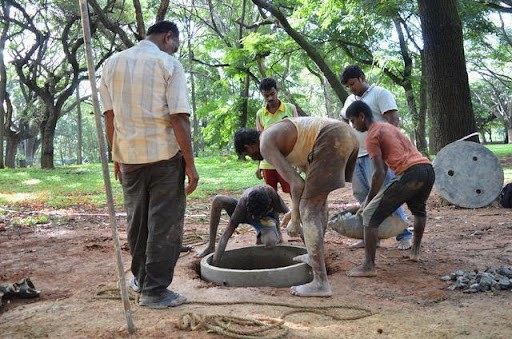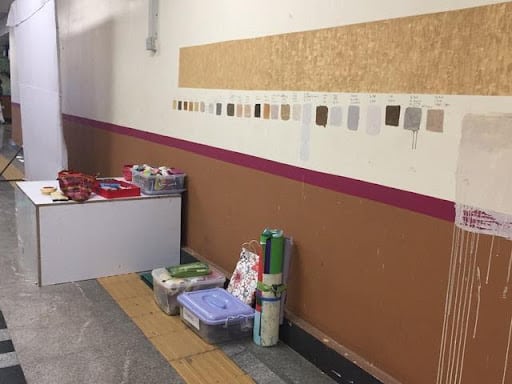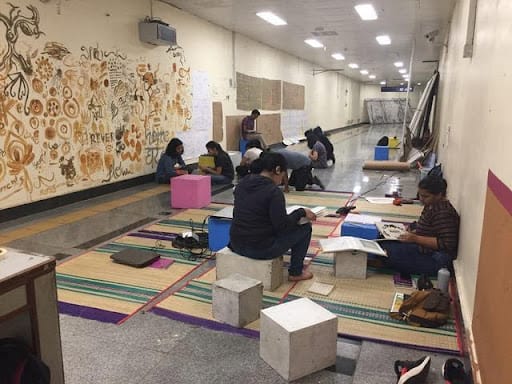If the outside of the Cubbon Park metro station is devoid of colour, step inside and the station is anything but colourless.
On an outside wall of the station is an end-to-end monochrome mural depicting tree trunks and children climbing them. Step inside, to the concourse next to the tracks, and the eye cannot help but catch the large colourful mural that captures the essence of what lies under the sprawling Cubbon Park—a massive groundwater recharge system. The theme that defines the artwork spread across the entire metro station.
“The idea is to make water practices in the city visible, water flows when we turn on our taps. But nobody knows what happens before or after that”.
says Arzu Mistry, an artist and faculty at the Srishti Institute of Art Design and Technology.
Water pipes, borewells and other water systems that serve the city have become invisible – with roads, footpaths and buildings constructed over them. The aim of Arzu and her collaborators “is to make the invisible, visible”. Especially the dangerously depleted groundwater levels in Bengaluru.
The art project at the metro station was the beginning. The hard work on the ground to actually do something about it was the next step—to dig a million manhole size pits or wells across Bengaluru for rainwater to seep through to replenish the groundwater
The brainchild of Biome Environmental Trust, an organisation working on water conservation, the twin objectives here are water conservation and reviving livelihoods by involving the Bhovis, also called Mannuvadars, a traditional well-digger community, in the effort.
“The idea is to integrate livelihoods as well as raise Bengaluru’s groundwater table”, says Shubha Ramachandran, water project manager at Biome and actively involved with the million wells campaign.
Read more: Bengaluru, second highest in rainwater harvesting in Indian cities
A slice of the underground
Cubbon Park alone will have 65 of these recharge wells. “This is a slice of the underground,” says Arzu about the art project at the metro station, which is designed as a metaphor for these recharge wells in the park.
“We are cutting into that surface where you can see Cubbon Park on top and the metro below so that people who are standing on the platform or the concourse are going to look at this cross-section of earth and engage with the underground water systems,” says Arzu.
Arzu and her art team used the mud that members of the Bhovi or Mannu Vaddar community removed while digging these wells. “Mud is a solid connection,” says Arzu. “The mud has come from the park where citizens walk and now it is at the nearby station used by citizens for commuting”.
Art in Transit and Biome Environmental Trust are jointly organising a virtual celebration of the culmination of the Namma Ooru Namma Neeru project, on September 4th, 5 pm. Witness the creation of the earth mural at Cubbon Park metro station, meet well-diggers from the Bhovi community, and enjoy poetry by Kaavya Sanje. Register here.
Biome introduced the artists to the skilled Bhovis when they were digging wells in the city’s Sarjapur area. They then conducted workshops with the well diggers where they recorded the community’s stories and practices. A group of poets called Kavye Sanje, led by poet Mamta Sagar, also participated in these workshops. Kavye Sanje wrote the poems based on their interactions with the Bhovis. Some of this poetry is part of the mural and some will be performed by the poets at events to be held at the metro station.
But the core of the artwork is water. Within this context, the artists plan to take water conservation from being a scientific, geological or technical issue to being a wider social and cultural one. “The artwork should give a sense of evocation when people engage with it,” is their concept behind this endeavour.

Art in Transit project
Arzu was already creating art at the Cubbon Park metro station as the lead of the Art in Transit Public Project – a collaboration between the Bangalore Metro Rail Corporation Limited (BMRCL) and Srishti Institute – which aims to create a platform for people in contemporary public art practice to come together.
Another artist had pitched to the BMRC the idea of painting the birds of Cubbon Park on the metro station walls. While Metro management was deliberating on the proposal, the artist got Wipro to support the project. However, when Wipro officials visited the metro station, they were excited about Arzu’s work. So the artists wrote a new proposal together on groundwater, and roped in Biome as knowledge experts.
“We understand how water works in the city to a large extent, and the sources of groundwater,” says Shubha Ramachandran. Biome, being domain experts, provided information and suggested ideas on what could be included. Artists from Srishti were then able to communicate those ideas in their artwork.
“We wanted to tell the story of Bengaluru and its water, and more specifically Cubbon Park and its water,” says Shubha. “We could spread the word about shallow aquifers and the well diggers, especially at Cubbon Park, in ways we had not done before”.
Yash Bhandari, an artist at Srishti, took the lead in writing the proposal with Biome. Design Earth, ecological designers, lent expertise in developing paint with mud. Place Arts Youth Collective worked alongside the Srishti team and students to paint the mural. This project is financed by an April 2019 Namma Ooru Namma Neeru grant supported by the Bengaluru Sustainability Forum (BSF).
Once the mud from the well diggers was brought, the artists began developing the palette and content of the mural. They also developed a whole bunch of stencils to be used as symbols or icons in the artwork. They used these stencils as the graphic element of the mural and the mud as the organic element.

Read more: Towards water security: How to dig a recharge well
Community involvement
These different bits and pieces constitute the flow of the mural’s imagery. The mural design was put together by students of two courses Arzu facilitated – ‘Story as Explanation’ and ‘Picturing Processes and Phenomena’ under the Creative Education Program at Srishti.
The team organised multiple community paint days, and over 300 citizens participated in the painting of the mural, drawn to the aesthetics of the mud. “We use this as a starting point for conversation on the project and to connect commuters to the resources to dig recharge wells in their community,” says Arzu.

As the art work inched towards completion, it was thrown open to the public in December 2019. Work had to be paused during the lockdown. Today, although the mural is complete, the team has been working on signage and documentation of the project off site, with Yash leading this effort.
Every metro station is not only a particular point on the map but also has a historical milieu. “All the work that we do is in response to the context and place based aspect of the site,” says Arzu. “That’s why the Cubbon Park metro station captures the craftsmanship of the well diggers who created the wells in the park”.
The other thing that interested Arzu is that metro stations are sites of transience where people are moving, yet there is a sense of familiarity as regular commuters visit these same spots every day. She has leveraged this aspect to draw commuters’ attention to Bengaluru’s water problems depicted in the mural.
Through this collaboration, Arzu hopes BMRCL can identify itself with the green initiatives in Bengaluru and partner in the moves towards sustainability. “We hope BMRCL can see itself as facilitators of much larger initiatives around ecology within the context of the Metro”. Through this artwork the art team has also endeavoured to shed light on people with limited access to clean water. “The idea is for citizens to think about issues of bottled water, privatisation of water, and recharging a well whose direct benefit you may not get but is part of a larger system,” says Arzu. “It is a process, let’s see if we get there through a mural”.

Namma Ooru Namma Neeru is a grantee of Bengaluru Sustainability Forum’s Small Grants Programme. More information about the project is available here.
I have around 70 honge tree saplings ready for planting
Contact me if u require these saplings
I live in central. BLR